The following is a compilation of significant dates in our Commonwealth’s military history. For more on the legacy of our Citizen-Soldiers and Airmen, visit the
Kentucky National Guard eMuseum.
[caption id="" align="aligncenter" width="500"]
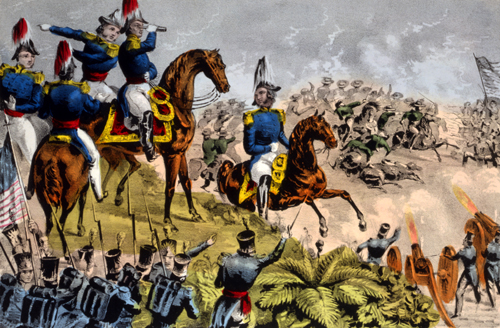
Battle of Buena Vista, Mexico, Feb. 22-23, 1847.
February 1 – National Freedom Day. Honors the signing by President Abraham Lincoln of a resolution that later became the 13th Amendment to the U.S. Constitution. Lincoln signed the Amendment outlawing slavery on Feb. 1, 1865
February 3, 1900 – Daniel Ray Collier and John Breckinridge Castleman serve simultaneously as Adjutant General of Kentucky following the disputed 1900 governor’s election. Collier was the re-appointed Adjutant General under Gov. William S. Taylor, he remained in office in the Old Capitol, until May 22, 1900, at which time he yielded the office to General Castleman in compliance with a U.S. Supreme Court order.
February 4, 1818 – $300.00 appropriated to pay for a plan for a state armory in Kentucky.
February 4, 1917 – Harold Hite of Company A, 3
rd Kentucky Infantry Regiment died of Pneumonia while on Federal Duty during the Mexican Border Campaign.
February 5, 1951 – Battle of Hill 440 began (Korean War)
[caption id="" align="aligncenter" width="300"]
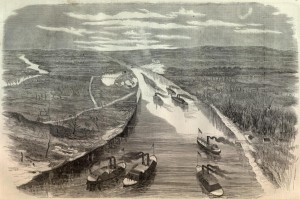
The siege of Fort Henry on the Tennessee River, February, 1862.
February 6, 1862 – Fall of Fort Henry on the Tennessee River, followed by Fort Donelson on the Cumberland River, Tennessee. (Civil War)
February 6, 1992 – Kentucky Air National Guard C-130 crash in Evansville, IN. Maj. Richard A. Strang, Capt. Warren G. Klingaman, Lt. Vincent D. Yancar, Master Sgt. William G. Hawkins and Master Sgt. John M. Medley perished during a training flight, when their Kentucky Air National Guard Lockheed C-130B struck Drury’s Inn Motel and then crashed into JoJo’s restaurant exploding into flames. Eleven persons on the ground were killed.
February 8, 1778 – Daniel Boone and 27 men with him captured at Blue Licks by Indians.
[caption id="" align="alignleft" width="228"]
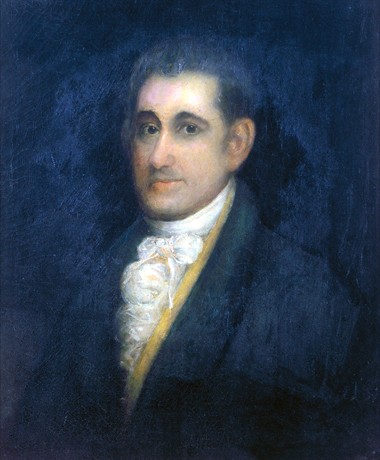
John Adair
February 10, 1816 – Gen. John Adair receives “the highest approbation and thanks of the legislature” of Kentucky, for his gallantry at the battle of New Orleans, and more particularly for the deep interest he took in vindicating a respectable portion of the troops of Kentucky from the inappropriate imputation of cowardice, most unjustly thrown upon them” by Gen. Andrew Jackson.
February 11, 1820 – Birth of Theodore O'Hara. A Danville, Ky., native and Civil War Veteran, O'Hara penned the famous "The Bivouac of the Dead" a poem which is inscribed on monuments across the country including the gates of Arlington National Cemetery. He died June 6, 1867 and his remains were re-interred in Frankfort in 1873.
February 11, 1860 – Gov. Beriah Magoffin of Kentucky directed to procure suitable gold medals, to present, in the name of the state, to each of the surviving Kentucky volunteers in the Battle of Lake Erie on September 10, 1813.
February 11, 1917 – Capt. Estel E. Owsley, Company H, 2
nd Kentucky Infantry Regiment from Middlesboro died at Fort Thomas, Kentucky. He took ill on the trip from El Paso, TX to Kentucky as the unit returned from federal duty on the Mexican border.
February 12, 1973 – Operation Homecoming began (Vietnam War)
February 13, 1957 – United States Property & Fiscal Officer (USP&FO) Kentucky offices and warehouse facilities located on Bowman Field was destroyed by fire. Total property loss exceeded $250,000.
February 15, 1898 – Sinking of the USS Maine in Havana Harbor, Cuba. (Spanish-American War)
February 16, 1951– Siege of Wonsan began. (Korean War)
[caption id="" align="alignright" width="220"]
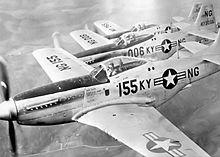
P-51 Mustangs of the Kentucky Air National Guard.
February 16, 1947 – Federal recognition of the Kentucky Air National Guard units granted by National Guard Bureau. Original units of the Kentucky Air National Guard were: HQ, 123
rd Fighter Group; HQ Detachment, 223
rd Air Service Group; Detachment A, 223
rd Air Service Group; 165
th Fighter Squadron; 165
th Utility Flight; 165
th Weather Station.
February 19, 1849 – Act passed directing the “the following names of battles and campaigns be inscribed upon the bands of the State Military Monument (Frankfort cemetery): Boonesborough, Blue Licks, Estill’s Defeat, St. Clair’s Defeat, Harmar’s Defeat, Wayne’s Campaign, Indian Wars, Tippecanoe, Raisin, Mississiniwa, Fort Meigs, Thames, New Orleans, Monterey, Cerro Gordo, Buena Vista, Mexico; that the names of such distinguished citizens of Kentucky as fell in said battles, campaigns and Indian Wars be inscribed on the shaft, beneath said bands; and that the dedication on the monument shall show that it is erected by a grateful country in honor of the private soldiers, equally with that of the officers.”
February 19, 1945 – US Marines landed on Iwo Jima. (World War II)
February 20, 1850 – From the Kentucky Legislature. The thanks and gratitude of the people of Kentucky, and a sword, tendered to Sgt. William F. Gaines of Georgetown, “the boy defender of the glorious banner of the 2
nd Regiment of Kentucky Infantry, at the Battle of Buena Vista;” his name to be inscribed on a plate of metal, and attached to the flagstaff of the colors.
February 22, 1917 – 1
st Sgt. William C. Liles of Company H, 3
rd Kentucky Infantry Regiment from Hartford, Ohio County, Kentucky died of pneumonia while on active federal duty near El Paso, TX. Liles joined Company H when it was formed in 1906. (Mexican Punitive Expedition)
February 22, 1967 – Operation Junction City began. (Vietnam War)
February 22-23, 1847 – Gen. Zachary Taylor, after two days of severe fighting, wins a great victory over the Mexican Army at Buena Vista — A small American army under the command of Gen. Taylor defeats a much larger force commanded by Gen. Santa Anna, President of Mexico. About ninety percent of Taylor’s army was composed of state volunteer (Guard) units, several of which were heavily engaged in the fight. The 2
nd Kentucky Volunteer Infantry’s, second in command, Lt. Col. Henry Clay, Jr. (son of the famous former Secretary of State and Speaker of the House of Representatives) was killed while leading his men in blunting the Mexican assault. The 1
st Mississippi Rifles, under the command of Col. Jefferson Davis (a Kentuckian and future U. S. Secretary of War and President of the Confederacy) and the 2
nd Kentucky Cavalry charged into the flank of the Mexicans routing them off the field. (Mexican-American War)
[caption id="" align="aligncenter" width="400"]
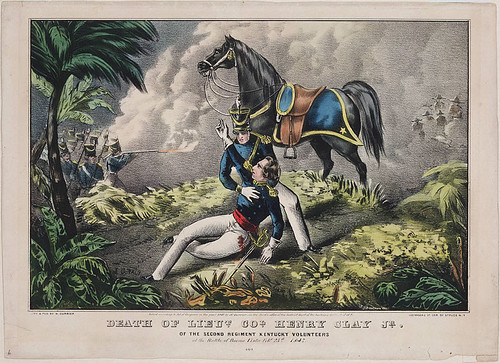
Death of Henry Clay Jr. at the Battle of Buena Vista, Mexico, Feb. 23, 1847.
February 23, 1847 – Resolutions passed by the Kentucky Legislature, complimentary to the Louisville Legion, and to Gens. Zachary Taylor and William O. Butler for their gallantry in Mexico, and directing the presentation of a sword to each of those generals, and to the widow of Maj. Philip Norbourne Barbour. Barbour fell at Monterey, and his body was directed to be buried in the state cemetery at Frankfort (Mexican-American War)
February 23, 1854 – Kentucky Legislature directs a sword to be presented to Henry E. Read, of Larue County, late ensign in Col. Andrews’ regiment of voligeurs, for gallant services in bearing the flag of his country through all the battles in the valley of Mexico, until he fell covered with wounds under the walls of Chapultepec.
[caption id="" align="aligncenter" width="284"]

Iconic photograph by Joe Rosenthal of Marines raising American flag on Mt. Suribachi, Iwo JIma, Feb. 23, 1945.
February 23, 1945 – U.S. Marines raised flag on Mt. Suribachi at the Battle of Iwo Jima. (World War II)
February 23, 1969 – Post-Tet Offensive began (Vietnam War)
[caption id="" align="alignright" width="350"]
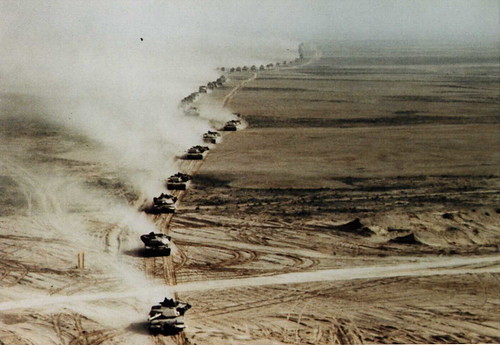
U.S. military tanks and armored vehicles cross the desert near the Kuwaiti border during Desert Storm, Feb. 24, 1991.
February 24, 1991 – Operation Desert Storm ground campaign began.
February 25, 1848 – $15,000 appropriated to pay for a military monument in the state cemetery, “to commemorate the deeds of Kentucky’s gallant dead.”
February 25, 1871 – In making excavations at Monroe, Michigan, 30 human skulls and numerous bones were exhumed, the remains of Kentuckians massacred following the disastrous battle of the River Raisin.
February 26, 1991 – Battle of 73 Easting (Desert Storm)
February 27, 1991 – Battle of Medina Ridge (Desert Storm)
February 27, 1991 – Battle of Norfolk (Desert Storm)
February 28, 1847 – Gen. Alexander Doniphan (born, Maysville, Ky.) defeats the Mexicans at Sacramento, in Chihuahua. (Mexican-American War)
February 28, 1867 – Dr. John M. Johnson, petitions the Kentucky Legislature an appropriation for the purpose of re-interring, in cemetery grounds at Atlanta, Georgia, the Kentucky Confederate dead who fell at Chickamauga, Missionary Ridge, Dalton, Atlanta, Decatur, Jonesboro, and in East and Middle Tennessee; about 300 identified and 200 unidentified.
[caption id="" align="alignright" width="338"]
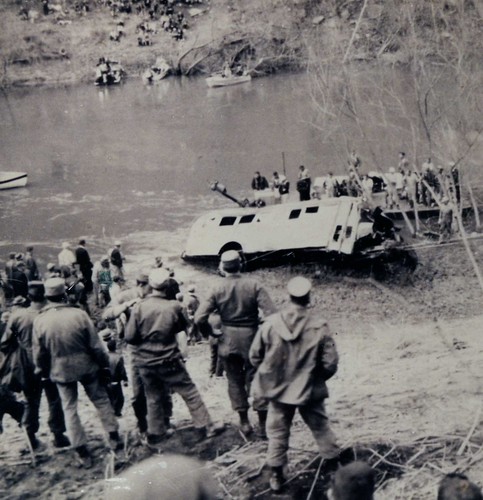
Kentucky Guardsmen assist with the recovery efforts following the Prestonburg bus crash, Feb. 28, 1958.
February 28, 1958 – Prestonsburg School Bus Disaster – What was then called the “worst traffic accident involving school children in the history of the United States” happened near Prestonsburg, Ky., when a school bus containing 48 children hit a wrecker and swerved into the flood swollen Levisa Ford of the Big Sandy River and disappeared. Twenty-two children escaped the bus before it sank and was swept away. The last body was not recovered until May 10
th. The Kentucky National Guard assisted with the recovery operations.